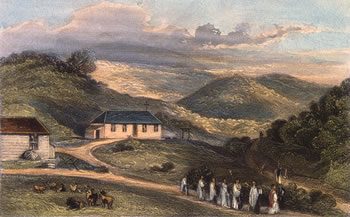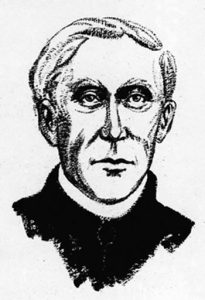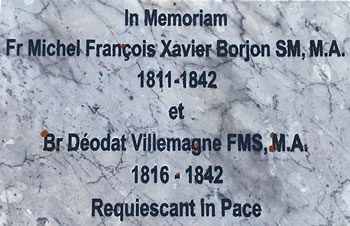Fr Jeremiah O’Reily OFMCap…
... and the Early Catholic History of Wellington (2)
After a year in Wellington, Henry Petre decided to return to England and find a wife before settling in New Zealand permanently. The full details are not known, but while in England Petre raised the fact that Wellington was in need of a priest. There is reason to believe that Wellington’s Catholics wanted a priest who was English or at least English-speaking.
However, English priests were in very short supply. A letter asking for help was sent to Archbishop Daniel Murray of Dublin. This request was passed on to the prominent Capuchin temperance leader, Fr Theobald Mathew, who asked for volunteers for a seven year assignment. The man who answered the call was a Capuchin Friar, and Guardian of the Order’s Friary in Kilkenny. About 37 years old, Father Jeremiah O’Reily OFMCap was both an unusual, and exceptionally fine, candidate for the position.
O’Reily had become a novice in the Capuchin Order in 1826, taking the name ‘Joseph’. It was as Fra Giuseppe that he entered the friary of Frascati near Rome. After his ordination, Fr O’Reily was eventually recalled to Ireland, where, after some time in Dublin, he took up his position as Friary Guardian in Kilkenny. As a member of a communal order, it would be hard for him to live in isolation from his fellow friars for a long period. On the other hand, O’Reily was already noted for his energy and missionary zeal, having recently applied to serve in Scotland, and having shown his leadership ability in the Temperance movement. O’Reily was accepted, and went on to become one of the most remarkable figures in the history of the Church in New Zealand.

Catholic chapel, Wellington, between 1842 and 1845 engraved by H Melville from an original by S C Brees. 1847; used with permission, Alexander Turnbull Library, Wellington, New Zealand
His biographer, Fr Owen O’Sullivan OFMCap, records that he was born in July 1805, but there is uncertainty about this. Other sources suggest he was born in about 1799. What we do know is that he was born into a merchant family in Cork, and was sent, with his sister, to be educated in France. A keen linguist, O’Reily’s understanding of French language and culture stood him in good stead in later years when he worked closely with French members of the Society of Mary.
Fr O’Reily never kept a diary, nor did he leave us a collection of personal correspondence, but alongside the testimony of those who knew him, something of his passion for theology, and his sense of humour, can be gleaned from his lifelong love of book collecting. Ruth Lightbourne of the New Zealand National Library made a study of his surviving collection of books in 2007. A few themes emerge. He clearly read deeply in Catholic theology, and his books, such as a set of sermons of St Bonaventure, were often heavily annotated. He had a fascination for rarity and antiquity, in some cases spending a great deal to acquire very early printings of medieval works. More revealing, however, are the flashes of humour. In the margins of his copy of ‘Voyage de Siam’, published in 1686, Fr O’Reily noted down some of the trials and tribulations he had faced in his New Zealand mission. Underneath, he dryly remarked, “The Dutch got the Cape for a little tobacco and gin”.
During 1842 Bishop Pompallier was making plans for a permanent Marist presence in Wellington. It was arranged that a Marist priest and brother would open a station there. And so it was that Fr Michel Borjon SM became the first priest appointed to serve in Wellington. Just 30 years old, he had been in New Zealand less than a year. Despite the physical hardships of his life, he was full of enthusiasm for his mission. In a letter to Jean-Claude Colin on 21 January 1842, he wrote, “Here are fought face to face, heresy, infidelity, and here are these people taught the truths of salvation…”. Accompanied by 26 year old Brother Déodat, he set sail from Auckland on board the Speculator on 1 August 1842. They were never seen again. Wreckage from the lost ship washed up on the East Coast weeks later. On 17 February 2013 Archbishop John Dew unveiled a memorial to these pioneers of the Church in Mount Street Catholic cemetery on a hill above Wellington, near Fr O’Reily’s grave.
It was on the very same day that the ill-fated Speculator set out that the Thomas Sparkes sailed from England with Fr O’Reily, Henry Petre, and his new wife Eleanor on board. It is a testimony to Fr O’Reily’s lifelong ability to reach out to non-Catholics in charity that he was invited to lead general prayer services during the voyage.
The Thomas Sparkes arrived in Wellington on 31 January 1843. It had been an eventful voyage under a hard-drinking captain, which culminated in a dangerous collision at the entrance to Wellington Harbour. Having arrived safely, Fr O’Reily immediately wrote to Bishop Pompallier to ask for priestly faculties.



 Entries(RSS)
Entries(RSS)